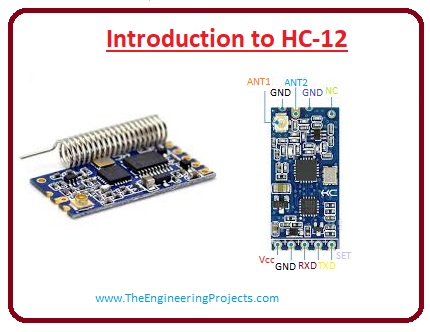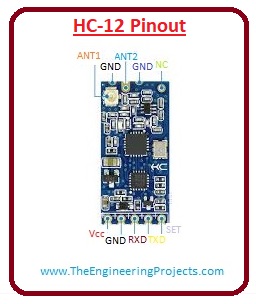
Hello friends, I hope you all are doing great. In today’s tutorial, we will have a look at a detailed Introduction to HC-12. It is a wireless data transmitter and receiver module, that uses 433 megahertz frequency and can communicate to one thousand meter distance. It can communicate with more than one microcontroller. This module operates from 3.2 volts to 5.5 volts.
This Bluetooth module is installed in industries to control different processes and machines. It is also used in the circuitry of different security systems. This module uses silicons LABs Si4463 for (radio-frequency) RF data transmission. In today's post, we will look at its working, features, pinout and applications in detail. So let's get started with Introduction to HC-12.
Introduction to HC-12
- HC-12 is an RF module, used for wireless data transmission.
- Its operating frequency range is from 433.4 to 473 megahertz, large no of channels can be tuned on this frequency range.
- The maximum sending information power of this module is one hundred megawatts or twenty-decibel milliwatts.
- The data receiving strength is -117 decibel milliwatts with a baud rate of five thousand bytes per second in the air.
- This device uses stamp hole packaging for patch soldering, having a dimension of 27.8-millimeter x 14.4-millimeter x 4 millimeters, consisting of an antenna cap that makes it easier to install in different circuitry.
- This module also consists of a printed circuit board (PCB) antenna socket and an external antenna can be connected by coaxial wire.
- This data transmission module also consists of the microcontroller, used to generate the data protocol.

HC-12 Pinout
- Now we discuss the pinouts of HC-05.
| Pin# | Type | Parameters |
| Pin#1 | Vcc | At this pin input supply is provided to this module, the range of direct current source is 3.2 volts to 5.5 volts, and the load connected with it should be two hundred milliamperes. One thing you should keep in mind that when this module sending data tries to connect 1N4007 diode in series voltage source if its value is larger than 4.5 volts for reduction of heating. |
| Pin#2 | GND | This pinout is connected with the ground. |
| Pin#3 | RXD | It is UART (Universal Asynchronous Receiver/Transmitter) input data and TTL (Transistor-Transistor Logic) pinout. The resistance of one kilo is linked in series within the module. |
| Pin#4 | TXD | it is UART (Universal Asynchronous Receiver/Transmitter) output data and TTL (Transistor-Transistor Logic) pinout. With this pinout, one-kilo ohm resistance is connected in series. |
| Pin#5 | SET | This pinout is for the setting of different parameters at active low level. One kilo ohm resistance is also connected with it in series. |
| Pin#6 | ANT | This pinout is for 433 megahertz antenna. |
| Pin#7 | GND | it is the ground pinout. |
| Pin#8 | GND | This pinout is also connected with the ground. |
| Pin#9 | NC | It is not used for any connection. |
| ANT1 | ANT | It is IPEX20279-001E-03 antenna socket. |
| ANT2 | ANT | 433MHz spring antenna solder eyelet. |
- The pinout from one to six consists of 2 bonding pads, with exterior half- holes bondings pads are manufactured for soldering.
- When the interior bonding pad antenna (ANT2) of pinout six is employed for linking, then the antenna connected with spring can be soldered with the hand.
- Let’s see a diagram of the pinout.

Features of HC-12
- This module can send and receive data to almost one thousand kilometers with a baud rate of five thousand bps.
- Its operating frequency range is from 433.4 to 473 megaHertz, to the hundreds of communication channels.
- Its data transmission power is almost a hundred megawatts or twenty decibels.
- It operates at 3 different modes according to the circuitry in which it is employed.
- A microcontroller is configured on this module so there is no need for a special programming device.
- It transmits a large number of bytes bits to the receiving module.
- It used a serial port for data transmission.
- Its operating voltage range is from 3.2 volts to 5.5 volts.
- It used the UART and TTL protocols for interfacing with other devices.
- It operates at minus forty degrees Celsius to plus eighty-five degrees Celsius.
Where to use HC-12
- These devices are used in pairs only and simple transmission of data is done by this device. That means its transmitter is used only for sending of data and its receiver for receiving data.
- With sending information to one thousand meter distance it is also used for short-range almost three meters of data transmission.
HC-12 Applications
- These are some important applications of HC-12 that are described here in detail.
- Different wireless sensors consist of this module.
- For the control of robotic instruments, it is used in these modules.
- In industries, different machines are controlled from a larger distance.
- POS (point of sale) systems also used this module.
- It is also used in the keyless automobile entry system.
That is a complete article on HC-12 I have mentioned each and everything related to HC-12 in this post if you have any questions ask in the comments. Thanks for reading.



